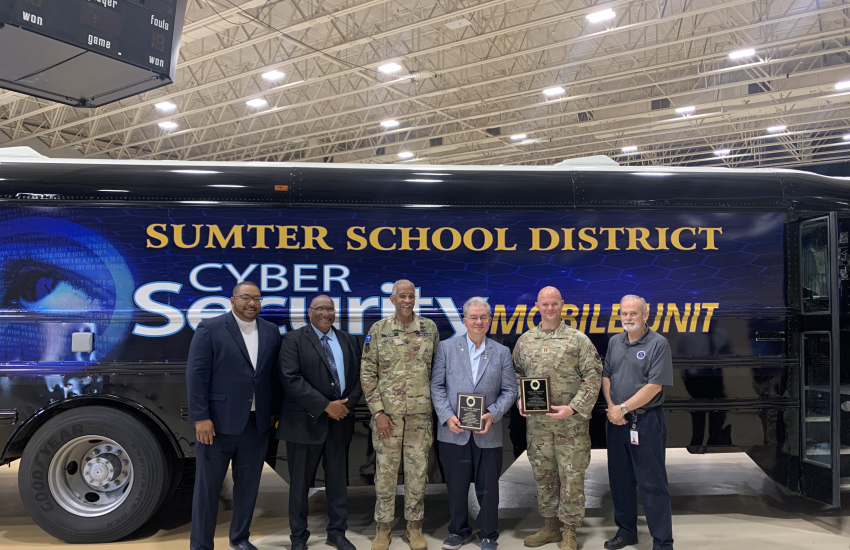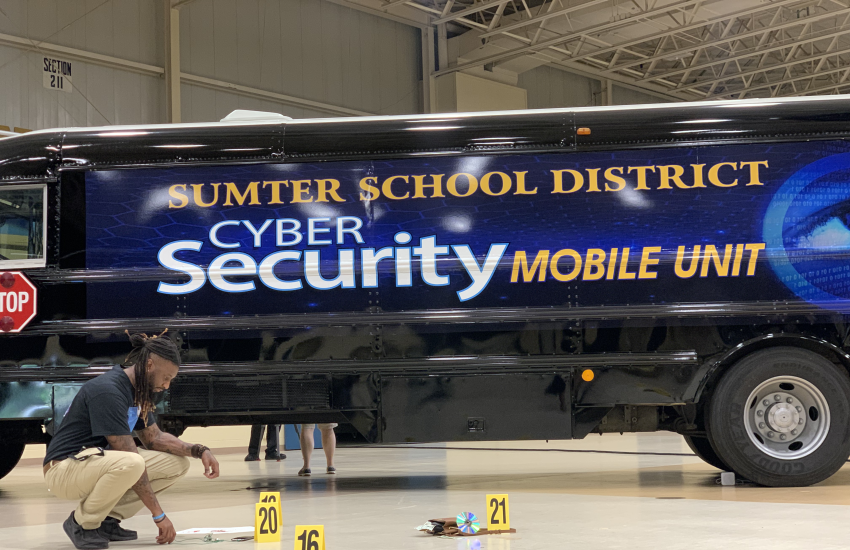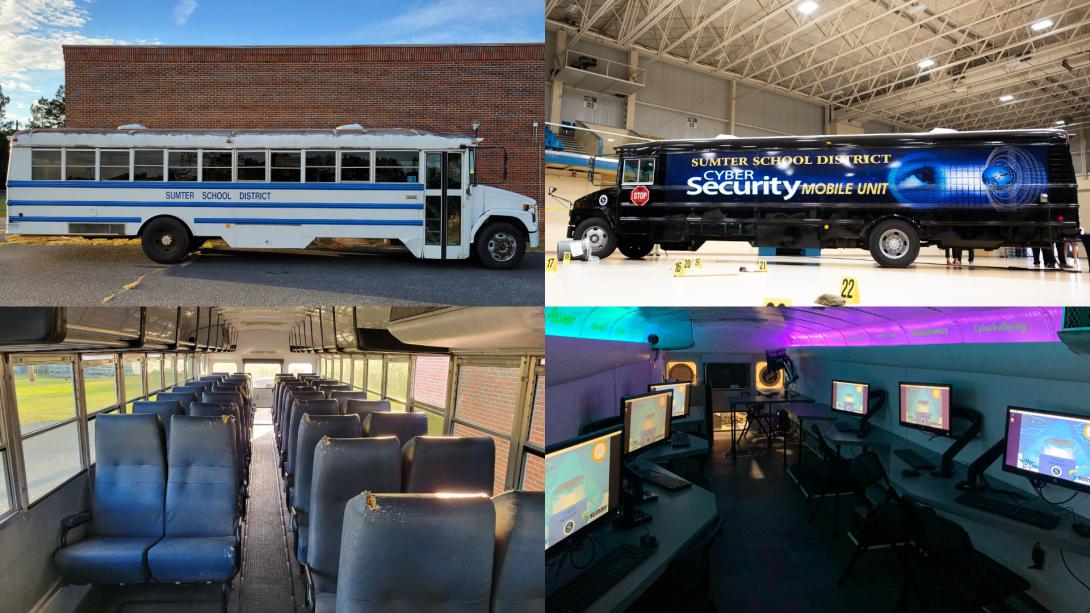Driving Future Cyber Warriors Forward
What used to be a 44-passenger school bus is now a mobile educational center for South Carolinian students enrolled in cybersecurity courses. Additionally, the platform will help teachers stay up to date on science, technology, engineering and math (STEM) knowledge and skill sets.
What is now simply referred to as the STEM BUSters, the project spearheaded by the Palmetto Chapter of AFCEA International, officially got rolling on July 26 in Sumter County, South Carolina.
It took months to rev up production, and it all started when Capt. Adam Levandowski, USAF, learned that no local school curriculum existed to enhance his son’s passion for robotics. So, he took matters into his own hands.
“I saw all this old equipment waiting to be dispositioned or thrown away,” said the U.S. Air Force cyber and communications operator, referring to the inventory that caught his attention during a flight mission he had worked. Motivated by his son’s needs and dreams, Capt. Levandowski had an idea to donate the otherwise “useless” military equipment to schools for educational purposes.
The donation process is known as Computers for Learning (CFL), a Defense Logistics Agency-led program that uses official supply chains and routing for disposition and donation.
Sumter School District eagerly asked Levandowski if he could do anything with a school bus, which advanced the idea into a large-scale initiative to educate the future cyber workforce.
After thousands of volunteer hours, in-kind and monetary donations—including a $5,000 check from the AFCEA International’s Educational Foundation—Levandowski and fellow volunteers from AFCEA Palmetto Chapter brought the STEM Cybersecurity Mobile Unit to life.
“Within 150 miles of Sumter, there are about 3,000 computer science and cybersecurity jobs that go unfilled every year,” says Richard Phillips Jr., STEM coordinator for the Sumter School District.

Levandowski's efforts to help the school district spurred Phillips to host a meeting among many local cybersecurity professionals. “Jaws had just dropped open because we all had experiences in cybersecurity but had never worked with each other,” Phillips said.
The meeting initiated a conversation to build a cybersecurity instructional pipeline for students from kindergarten to college.
“These are life-changing jobs,” Phillips said of the future career paths for many of students. The median salary for a cybersecurity professional in South Carolina is $105,000. “That’s where we want to position our students to be able to fill those jobs.”
Phillips’ journey through education has always been need-based. With a background in science and nanotechnology, he recalled an evening when a news program out of New Orleans reported 3,000 teacher vacancies following Hurricane Katrina. “I spoke to my wife and said, 'I need to go there.'”
Not two hours passed when Phillips received a phone call from a Louisiana school district to teach physics and chemistry.
The move ignited a newfound passion for Phillips, who years later created a cybersecurity club for middle school students, with the help of the Air Force Association’s CyberPatriot Program.
The initiative to build the cybersecurity mobile unit will greatly affect the future of all students, Phillips said.
Putting in the “blood, sweat and tears” alongside Levandowski was James Crawford, AFCEA regional vice president for the Carolinas Region. Crawford had served in the U.S. Air Force since 1965 and retired in 2012. During his time, Crawford also served in the Department of Defense Air Force Engineering and Technical Service as a systems integrator on command-and-control systems, 1989-2012.
Palmetto Chapter President Joe Kloiber and Gary Cornn, past chapter president, also joined in to help.
“They deserve all the credit in the world, and they did it for the children,” Phillips said, referencing the long hours—including evenings and weekends—the volunteers put into making this project happen.
The refurbished school bus served as a catalyst for the creation of the Sumter Cyber Innovation Council, which includes partnership from the Air & Space Forces Association, Shaw Air Force Base, Morris College, cyber.org, AFCEA and the Sumter Economic Development.
“In partnership with this coalition, the STEM BUSters will help identify and fill gaps for emerging cybersecurity professionals,” Crawford said. "This model can be replicated for any school system. There’s no reason we can’t do this again.”
For future STEM buses, however, Crawford would like to have enough sponsorship to bring in more modernized capabilities.
The bus features external computers for students and educators who cannot access the interior lab, as the layout is inaccessible to handicapped students and teachers. Crawford said he hopes future buses will accommodate Americans with Disabilities Act-accessible provisions to engage all kids equally.
At the launch ceremony in July, SIGNAL Media met with Aaron Johnson, the man taking charge of the path forward, literally and figuratively.
Cyber, however, wasn’t the only subject on the syllabus during the launch ceremony. Johnson, the first cybersecurity instructional specialist aboard the STEM Bus, set up a fake crime scene—including a purse full of money, a watch and fake blood—to showcase other critical skills students will need to develop. “I’m bringing the problem-solving skills to critical thinking and analytical skills,” he said, explaining the purpose of the crime scene.
While crime scenes will not always be part of the course, students will be encouraged to think outside of the proverbial box, for cybersecurity does not solely deal with codes and numbers. In this specific example, however, Johnson noted the use of digital forensics within cybersecurity.
Johnson’s 15 years of teaching science have revolved around creativity, and innovation is why the Sumter School District Director of Innovation David Laws nominated him for this position.
Johnson, who says he is still learning about cybersecurity, researches and forms connections within the cyber community to build his curriculum.
Starting with elementary schools, kids can finally hop on board in March, Johnson said.
However, he hopes to build excitement around STEM and cybersecurity before that. Referencing an idea he’s had for a long time, Johnson mentioned a STEM haunted house, aka SCREAM, which stands for science, cybersecurity, reading, engineering, art and math.
Crawford assured Johnson that his efforts have the continuous support of the Palmetto Chapter and AFCEA International.
The STEM Bus initiative has drawn excitement from across AFCEA, including the team at headquarters.
“I can’t wait to see the learning going on inside this fully connected and technically tricked out vehicle,” said Lt. Gen. Susan S. Lawrence, USA (Ret.), AFCEA International’s president and CEO.
“The innovative spirit, to literally strip this bus down to its bare shell and then fully equip it to teach a host of STEM-related topics to South Carolina’s students, is alive and well in our Palmetto Chapter!”
For Sumter School District’s Superintendent William Wright, this is the start of something big. “I think you’re going to see these all over the state and nation,” he stated.







Comments